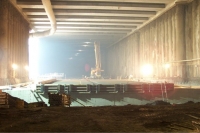Lainz Tunnel, LT 23 Contract Section
Client: Austrian Railways Infrastructure Construction AG
Development Period: 1991 to 2012
The LT 23 contract section is part of the railway link between the Western, Southern and Donaulände Railway Line in Vienna (Lainz Tunnel). This section consists of a hall with a length of 550 m where two tracks of the Western Railway Line run parallel with two tracks of the new line. The hall was built using a closed building method utilizing bored piles. The excavation featured a width of 25 m and a height of 15 m.
The tunnel structure is situated directly below the existing Western Line. Consequently, an undisturbed service on two tracks had to be ensured during the whole construction period.
BGG was commissioned with the supervision of the project regarding the geological, geotechnical and geohydrological consulting from the time the route was chosen until the completion of construction. The results of subsoil exploration were used to compile geotechnical and geohydrological expert's reports. Based on these reports, geomechanical models were devised that were necessary for the dimensioning of the bored piles. During construction, geodetic measuring points were supervised and inclinometer measurements and evaluations were carried out. Consequently, the excavation progress and the securing measures could be managed in an ideal way. Lastly, BGG was commissioned with the geological documentation.
Dimensioning of bored piles:
During the subsoil exploration, numerous laboratory analyses were conducted. Based on those results, BGG computed the values of the soil parameters that were needed for the dimensioning of the bored piles. Consequently, bored piles could be utilized that extended only slightly below the maximum excavation level.
The displacements were monitored constantly by utilizing inclinometers in the bored piles and taking geodetic measurements. These were compared with the results of the static model of the particular excavation site. When higher displacements occurred, the excavation process was carefully guided, and anchors were placed locally. Hence, the necessary safety level was provided in a cost-effective way.
Groundwater communication measures:
The tunnel construction cuts through the groundwater stream of the Wien valley. This required provisions for groundwater communication. BGG designed a concept that utilized water catchments on both sides of the structure. These were constructed by using gravel piles, which were connected through culverts below the bottom plate. Niches and revision shafts had to be considered in order to make the long-term maintenance of the system possible.
July 2005
